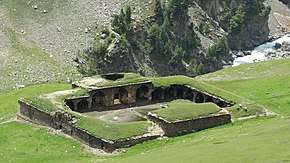Mughal Road
Mughal Road is a road in the Indian union territory of Jammu and Kashmir. It gives the rest of India access to the Kashmir valley other than the Jammu-Srinagar National Highway (part of NH 44).
| Mughal Road | |
|---|---|
 Aliabad Sarai, a halting point on old Mughal road | |
| Route information | |
| Length | 80 km (50 mi) |
| Major junctions | |
| East end | Shopian, Shopian district |
| West end | Bufliaz, Poonch district |
| Location | |
| States | Jammu and Kashmir |
| Highway system | |
| |

It branches off from NH 144A between Rajouri and Poonch at a point called Bufliaz in the Surankote tehsil of the Poonch district. It runs east along northern bank of the Poonch River to the Pir Panjal Pass (Peer Ki Gali). It then picks up the Rimbiara River and descends to Shopian, in the Shopian District, at the westerly edge of the Kashmir Valley. This segment, which passes through Behramgalla, Chandimarh, Poshana, Chattapani, Aliabad, Zaznar, Dubjan, and Hirpora, is 84 km long.[1] It is the key route from Poonch to Shopian; the journey of 126 km would otherwise take 588 km. For travelers between Jammu and the Kashmir valley, the Mughal Road is part of a rougher alternative to the Jammu-Srinagar National Highway.[2]
History
A route linking Hirapur (modern Hirpora) in the Kashmir Valley with Rajauri via the Pir Panjal Pass (Peer Ki Gali) has been use from ancient times. During the period of the sultans, it was extended to Bhimber. Historian Mohibbul Hasan says it played an important role during this period.[3]:23–24
After conquering the Kashmir Valley, the emperor Akbar strengthened the route into an "Imperial Road" stretching from Lahore to Kashmir.[3]:24 In modern times, the route has been referred to as the "Mughal Road".[4]
Construction
The new road was proposed in the 1950s, to improve the economy of the Kashmir valley. Then Chief Minister Sheikh Abdullah took up this project in 1979 and named it the "Mughal Road", but it came to a halt as terrorism took over. Bafliaz Bridge on the road was blown up by the terrorists.[5]
Actual construction began in October 2005 with a target of completion in March 2007 and an estimated cost of 255 crore rupees.[6] A conservation trust petitioned the Supreme Court to stop construction, citing the disturbance to animals in the Hirpora Wildlife Sanctuary, especially the endangered Markhor goat;[7] and claiming the road would get early snowfall in winter and hence would not serve as an alternate route to the existing Jammu-Srinagar highway. However, the Court gave conditional permission for the construction of the road.[6]
Construction was to be completed in December 2008,[8] but was delayed for a number of reasons, including the Amar Nath land row. The road was opened on 12 July 2009 for inspection by state legislators, officials, engineers, and others. It was supposed to be thrown open for light vehicles in October 2010 but the law-and-order situation in Kashmir in 2010 imposed delays.[1][9] A double-lane road was completed and opened for light vehicles in August 2012.[10]
A Mughal Road Car Rally has been held annually since 2010.[11] It covers 600 km, including the picturesque stretch across Pir Panjal.
References
- Sameer Arshad & M Saleem Pandit (24 March 2008). "Mughal Road: A blast from the past". The Times of India. Retrieved 6 May 2019.
- Hasan, Mohibbul (1959), Kashmir under the Sultans, Aakar Books, ISBN 978-81-87879-49-7
- "Now, Mughal Road To Connect J&K". The Times of India. 14 July 2005.
- "Archived copy". Archived from the original on 20 November 2008. Retrieved 15 December 2008.CS1 maint: archived copy as title (link)
- "Archived copy". Archived from the original on 13 November 2007. Retrieved 11 December 2008.CS1 maint: archived copy as title (link)
- "Archived copy". Archived from the original on 15 July 2011. Retrieved 11 December 2008.CS1 maint: archived copy as title (link)
- "Archived copy". Archived from the original on 21 July 2011. Retrieved 25 March 2009.CS1 maint: archived copy as title (link)
- "Mughal Road car rally: A royal voyage for thrill junkies". India Today (1 July 2012). Retrieved 25 August 2012.